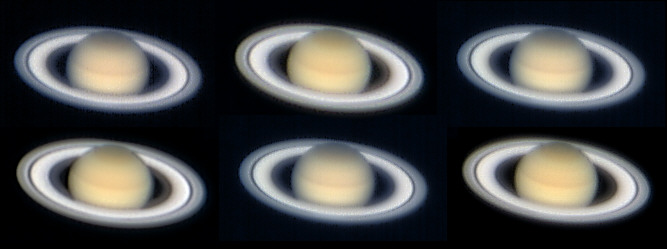
Sampling Saturn
(Trying to figure out the advantages/disadvantages of over-sampling in planetary imaging)
OK, here's the answer:

pixels / FWHM
4.5, 2.0, 4.5
2.0, 4.5, 2.0
Pros for 4.5 pixels/FWHM (f50): The Cassini Division does look sharper!
Pros for 2 pixels/FWHM (f23): Tonality, gradation and colour does look better, less noise, Crepe Ring, hint of Enke Minimum
Using the higher magnification is in practice much more difficult since just acquiring Saturn (and keeping it!) on the CCD was a huge challenge, despite having a 9x finder-scope. The planet spans over more than half the CCD. A parfocal eyepiece is almost an essential, a flip mirror might also help. I also have a nagging feeling that the seeing had deteriorated considerably by the time I got around to imaging at the lower magnification. By then the Moon had acquired a prominent halo from thin clouds. Besides, is the Celestron Ultima 2x Barlow of equivalent quality to the very much more expensive Televue 5x Powermate? So what to do next time? Stack the high magnification and the low magnification images? Probably OK for Saturn, but planets with intricate surface detail (Jupiter and Mars) would have rotated considerably by the time one has changed the scope setup, refocused, etc. Additionally, even though on images from larger scopes one can sometimes see the planet through the Cassini Division, on my mass produced C8 the above is perhaps the best I can aspire to... Conclusion: for relaxed imaging 2 pixels/FWHM can yield rather nice images; for occasional self-inflicted torture imaging at 4.5 pixels/FWHM is worth a try. Now, where can I find a Barlow or Powermate or a scope configuration that gets me halfway, around 3 to 3.5 pixels/FWHM ;-)
For other stuff, astro and normal photography, click Samir's Home